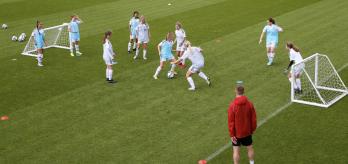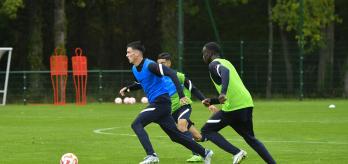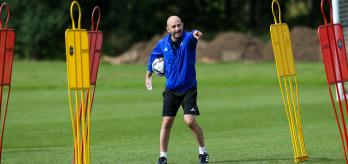In this third instalment, we return to the pitch to explore a new variation of Schmidt’s tactical activation exercises, one that sharpens the focus on decisive forward play and individual player development. While the previous sessions also emphasised forward-thinking football, this activity pushes players to break lines earlier, take greater responsibility on the ball, and embrace the risk-reward nature of vertical progression.
The format will be familiar to those who have followed Parts 1 and 2: three teams, three zones, and a dynamic interplay between possession, progression and transition. But subtle adjustments in team size, passing constraints and scoring rules shift the learning experience. The result is a session that not only prepares players physically, mentally, and tactically for the demands of Schmidt’s game model but also challenges them to take initiative, grow as decision-makers, and execute with precision.
The setup
This activation features three teams of three players — a smaller, more individualised setup compared to the four- and six-player teams used in earlier sessions. The game unfolds across three zones, with one team in each. The middle team acts as defenders, while the other two occupy the outside zones.
Session Management
Compared to Parts 1 and 2, this version is managed slightly differently, allowing for a clearer tactical focus on vertical progressions:
-
The defending team remains in their role for the entire round.
-
Each round consists of three balls served by the coach.
-
Play continues until the ball goes out of play or the defending team successfully returns it to the coach.
-
After each ball, the coach allows a brief pause for both teams to reorganise and recover.
Team Rotation
In addition, with four teams participating, the rotation is designed to ensure balanced exposure and maintain a high level of competitive intensity:
-
Each team sits out for one round.
-
Every team plays two rounds as attackers and one round as defenders.
-
Scores are tracked throughout the session, and the team with the most total points wins the competition.
Deliberate practice design
Small adjustments in rules, structure or coaching can dramatically change what players experience. In this version, Schmidt introduces two subtle but deliberate rule changes that shift the emphasis toward decisive forward play and immediate counter-pressing.
1. Passing Constraint
The key distinction in this version lies in the passing constraint. While previous activities required a minimum of ten passes before switching play, giving defenders time to organise and apply coordinated pressure, this exercise limits the attacking team to a maximum of five passes. As a result, players are compelled to think vertically, act quickly and take calculated risks in search of penetrating passes.
Info: Minimum vs. Maximum Passing Constraints
-
A minimum passing constraint prolongs time in possession, emphasising composure under pressure and the ability to resist pressing. It reduces the number of vertical progressions and allows defenders to organise, apply pressure and rehearse pressing behaviours more frequently.
-
A maximum passing constraint, on the other hand, accelerates play. It compels attackers to seek forward options early, increasing the frequency of risk-taking and line-breaking passes. This constraint maximises the number of forward passes attempted per round and fosters a mindset geared towards vertical progression and urgency.
2. Scoring System
A more subtle but important change in this tactical activation lies in the scoring system. As in previous versions, attackers earn one point for each successful forward pass into the opposite outside zone, rewarding decisive, line-breaking passes that outplay defenders.
However, defenders can no longer score immediately. To earn a point, they must now complete a short passing sequence: all three players must touch the ball before it is returned to the coach. This acts as a minimum passing constraint, demanding control and composure immediately after regaining possession.
More significantly, this rule creates a clear window for counter-pressing. By delaying the defenders’ ability to score, it allows attackers to react and apply pressure, making counter-pressing more frequent and realistic, and helping players to internalise it as a natural response during transitions.
Coaching Focus and Player Development
This variation of the tactical activation is deliberately designed to individualise the learning experience. With smaller teams, each player becomes more involved, receiving more touches, making more decisions and carrying greater responsibility for driving the play forward. This shift enables coaches to place a sharper focus on individual development.
Throughout the session, Schmidt consistently challenges players to treat the exercise as a genuine opportunity for growth. His coaching interventions go beyond tactical instructions, aiming to shape mentality and mindset. He reminds players that forward passes that break lines and eliminate opponents are decisive actions in football. Rather than settling for square or backwards passes, he urges them to play with ambition, intent and courage.
Schmidt encourages risk-taking as a necessary part of development. Players are told to trust their abilities, to look for the smallest gaps, and to exploit them with speed and precision. The emphasis is on playing with purpose, not simply maintaining possession, but using it to progress and make a difference.
Main Coaching Objectives
-
Decision-making: Players must quickly assess when and how to break lines, weighing the available options and acting with urgency.
-
Technical precision: Penetrative passes must be delivered with the right speed, timing and accuracy to exploit narrow spaces.
-
Risk-taking and confidence: Players are encouraged to take initiative and embrace the responsibility of being the one who changes the game.
These objectives compel players to think vertically, act decisively and adopt a proactive, forward-minded approach to possession. To support these outcomes, Schmidt provides a series of clear, actionable coaching points throughout the session:
Conclusion
While still part of the same tactical activation family, this third activity offers a significant shift in emphasis. With smaller teams, tighter passing constraints, and focused coaching interventions, the session puts individual decision-making, execution under pressure, and personal growth at the forefront. It is a faster, more direct and player-centred variation that contrasts with the more possession-oriented structure of the earlier exercises.
Roger Schmidt’s training design once again shows how subtle changes in the setup can produce new challenges and new learning opportunities. By shifting the parameters, he keeps players engaged, stretches their capabilities and reinforces the core behaviours of his playing style in a game-relevant, competitive context.

















